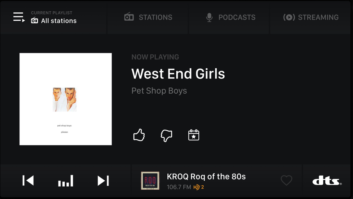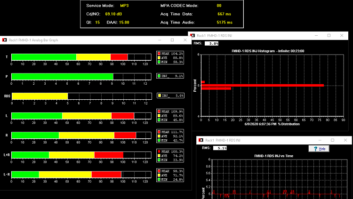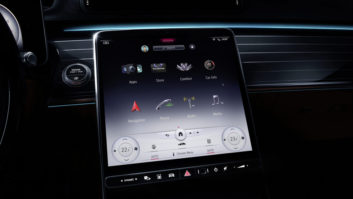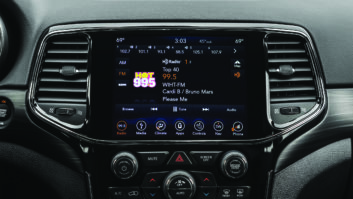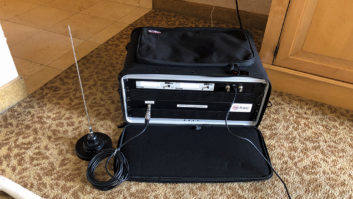
A typical implementation of HD Radio with Artist Experience in a 2013 GMC Acadia and Chevrolet Traverse. Both GM vehicles offer HD with AE as standard. The author was listening to KBIG(FM) in Los Angeles when he took this photo. In the past few months I’ve made several business trips to Los Angeles. Invariably these trips require renting a car, and I have been lucky to have been upgraded to a 2013 GMC Acadia or its closely related sibling the Chevrolet Traverse. Both are made by General Motors and offer HD Radio with Artist Experience as a standard feature.
I have always taken an interest in new radio receiver technology; these days my work with Clear Channel Media + Entertainment has me involved with it more than ever. That being said, it’s nice to finally see a product or feature the industry has been waiting for actually realized in a final product.
What’s more, since GM is offering these as a standard feature in 2013 and presumably future models of this vehicle, obtaining one of these radios for evaluation or purchase is now easier. I have seen this receiver on the demonstration floors at the Las Vegas Convention Center during CES and the NAB Show. It’s one thing to have a few minutes in the car at a trade show, quite another to drive the vehicle for a few weeks.
IMPLEMENTATION
Focusing on the receiver itself, GM has done an excellent job with its implementation.
The tuning knob, volume controls and touch screen are responsive. It’s easy and intuitive to set an HD1 or HD2 station as a favorite. The integrated steering wheel controls also allow you to scan stations, presets and change volume with ease. My only complaint is the soft buttons at the bottom of the radio to control the unit take some getting used to. Because the soft keys don’t provide any tactile response when depressing them, it takes some time to master their use.
Also, GM provides some tactile bumpers near these soft keys to help you find them while driving, but those bumpers were confusing to me at first. I thought I had to press those silver bumpers, but it turns out you have to touch the “Menu” or “Seek” labeling instead to get the appropriate response. Once you figure that out (and for me it wasn’t immediately intuitive), you’re off and running.
I find it easy to accidentally bump the emergency “hazard” lights that are located directly below the radio display. I would prefer hard keys that provide tactile response and also intentional pressing to activate the function desired by the key.
As a bonus for stations that are not transmitting HD Radio, GM has a good implementation of RDS features with Program Service and RadioText (RT) support on analog-only FM stations. A feature I would like to see GM consider is adding RadioText+ (RT+) to allow for analog-only FM broadcasts with RDS to provide a similar “look and feel” on the display to put it near par with HD stations using PSD.
Focusing directly on the HD implementation of the radio, GM has done a fantastic job. I’ve found in my cursory driving the blending to analog and digital is graceful. The performance of the audio on HD stations, Main Program Service MPS (HD1) and Secondary Program Service SPS (HD2, HD3, etc.) stations all works great.
The AM side sounds good, too. Los Angeles has several stations that transmit an AM HD signal, and it’s a real pleasure driving around the market to hear the analog blend into AM HD. In a few rough spots under bridges downtown, I found when the radio blended to analog on some of the 5 kW AM HD stations in the market, I couldn’t wait for digital coverage to resume.
ARTIST EXPERIENCE
But the real hero of the day is that GM has a solid implementation of Artist Experience (album art) via HD with this radio.
I noticed no issues with the implementation. The receiver also offers full station logo support.
I think the trickiest part is to listen to an HD station long enough for the receiver to initially acquire the station logo. Of the three rentals I’ve had, one had very low mileage and had not acquired any of the L.A. station logos.
I had to resist the urge to go channel surfing on stations that I know are transmitting a logo in the market and wait until the receiver acquired the image. That’s because the station logo often is sent infrequently to conserve bandwidth for other HD services.
The typical/default configuration from iBiquity is one station logo image per channel is sent every 15 minutes. This requires you to stay on the HD1 or HD2 (etc.) of a specific station for that time period so that the receiver can acquire the logo. The idea is the logo is something that, once acquired, will not change frequently, and will be stored in the receiver’s permanent memory.
For your core listeners, this condition will not be difficult to satisfy. GM does a great job with the permanent storage. Between driving sessions in both morning and evening, the radio retained all the station logos I had acquired all week. Subsequent rentals with higher vehicle mileage had acquired most of the station logos available in the market.
With the station logos acquired, the receiver transitions seamlessly from an album art image for a song, to the station logo, and into the next song’s album art image. GM’s implementation of Artist Experience and station logo has been perfect under my observations in the past few weeks. Better yet, it puts a very nice graphical face to radio — and offers a comparable experience to when the system plays songs that have album art off your iPhone or iPod.
COLLECTIVE EXPERIENCE
Perhaps most concerning is that as of my last check in mid-June 2013, only seven stations in the Los Angeles area were transmitting Artist Experience via HD. Of these seven, six belong to my employer, Clear Channel.
You may have heard iBiquity and others indicating automotive receivers that support HD and Artist Experience are coming. Well, they are out there. GM offers the technology in select models now as standard, and the list of other OEM’s out there with HD and Artist Experience in vehicles is growing rapidly.
Stations that do not have this technology implemented are at a disadvantage. Clear Channel Media + Entertainment and I have been a proponent in providing the industry with suggestive tips on how to implement this technology. At the NAB Show in April I presented on this topic, and I wrote an in-depth white paper on the implementation of this technology in the NAB Broadcast Engineering Proceedings, which are available from purchase from the trade organization.
I’m pleased to be partnering with the Society of Broadcast Engineers to provide an in-depth, live, interactive webinar on this topic on Thursday, Sept. 12 at 2 p.m. Eastern. Registration details are available at sbe.org. If you cannot attend the webinar live, it will be archived by SBE at the same site.
The presentation will focus on Artist Experience implementation via HD in three parts. First, I’ll focus on what types of receivers are out there now that support this technology, including pictures of various units and address their implementations. The second part of the presentation will examine the technical details of how Artist Experience works. And finally, I will discuss implementation strategies of Artist Experience to help you relate the theory behind the technology into reality. This will draw on the experience that we have collectively learned at Clear Channel as we rapidly implemented Artist Experience via HD Radio nationwide in 2012.
Alan Jurison is a senior operations engineer for Clear Channel Media + Entertainment’s Engineering and Systems Integration Group. He holds several SBE certifications including CSRE, CBNE, AMD and DRB. His opinions are not necessarily those of Clear Channel or Radio World.







